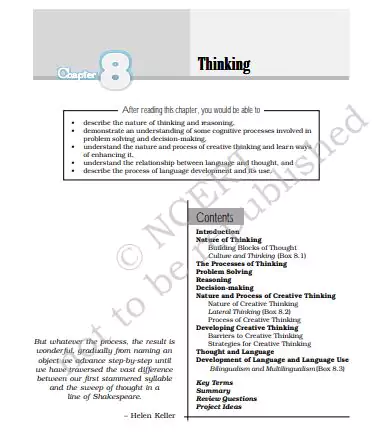‘NCERT Solutions for Class 11 Psychology Chapter 8 Thinking‘ PDF Quick download link is given at the bottom of this article. You can see the PDF demo, size of the PDF, page numbers, and direct download Free PDF of ‘Ncert Class 11 Psychology Chapter 8 Exercise Solution’ using the download button.
Thinking Explanation NCERT Textbook With Solution PDF Free Download

Chapter 8: What Is Thinking
Thinking is the base of all cognitive activities or processes and is unique to human beings. It involves manipulation and analysis of information received from the environment.
For example, while seeing a painting, you are not simply focusing on the colour of the painting or the lines and strokes, rather you are going beyond the given text in interpreting its meaning and you are trying to relate the information to your existing knowledge.
Understanding the painting involves the creation of new meaning that is added to your knowledge.
Thinking, therefore, is a higher mental process through which we manipulate and analyse the acquired or existing information.
Such manipulation and analysis occur by means of abstracting, reasoning, imagining, problem-solving, judging, and decision-making.
Thinking is mostly organised and goal-directed. All day-to-day activities, ranging from cooking to solving a math problem have a goal.
One desires to reach the goal by planning, recalling the steps that one has already followed in the past if the task is familiar or inferring strategies if the task is new.
Thinking is an internal mental process, which can be inferred from overt behaviour.
If you see a chess player engrossed in thinking for several minutes before making a move, you cannot observe what he is thinking.
You can simply infer what he was thinking or what strategies he was trying to evaluate, from his next move.
Building Blocks of Thought We already know that thinking relies on knowledge we already possess.
Such knowledge is represented either in the form of mental images or words. People usually think by means of mental images or words.
Suppose you are travelling by road to reach a place, which you had visited long back.
You would try to use the visual representation of the street and other places. On the other hand, when you want to buy a storybook your choice would depend upon your knowledge of different authors, themes, etc.
Here, your thinking is based on words or concepts. We shall first discuss mental image and then move on to concepts as the base of human thought.
How do we proceed while repairing a broken cycle, or planning a summer tour or patching up a broken friendship?
In some cases the solution is reached quickly as in repair of a bicycle based on immediately available cues whereas others are more complex and require time and effort. Problem-solving is thinking that is goal-directed.
Almost all our day-to-day activities are directed towards a goal. Here it is important to know that problems are not always in the form of obstacles or hurdles that one faces.
It could be any simple activity that you perform to reach a defined goal, for example, preparing a quick snack for your friend who has just arrived at your place.
In problem solving there is an initial state (i.e. the problem) and there is an end state (the goal).
These two anchors are connected by means of several steps or mental operations. Table 8.1 would clarify your understanding of various steps through which one solves a problem.
You can try out the problems given in Activity 8.3 with your friends and observe how they are approaching the problem.
You can ask them the steps they follow while solving these problems.
| Author | NCERT |
| Language | English |
| No. of Pages | 20 |
| PDF Size | 1.5 MB |
| Category | Psychology |
| Source/Credits | ncert.nic.in |
NCERT Solutions Class 11 Psychology Chapter 8 Thinking
Question 1. Explain the nature of thinking.
Answer: Thinking is a complex mental process involved in manipulating and analyzing information, either collected through the senses from the environment or stored in memory from past experiences.
Such manipulation and analysis occur by means of abstracting, reasoning, imagining, problem-solving, judging and decision-making. It is an internal process that can be inferred from overt behavior.
Main features:
- Thinking is the base of all cognitive activities.
- It involves manipulation and analysis of information received from the ! environment.
- Thinking is mostly goal-directed and one desires to reach the goal by planning. Two building blocks of thinking?
- Thinking is a complex mental process and people think by means of mental images or concepts.
- Mental image refers to an image which is a mental representation of a sensor}’ experience. In this we actually try to form a visual image of the whole situation.
- A concept is a mental representation of a category. It refers to a class of objects,
ideas, events that share common properties, e.g. When we encounter new social situation, we try to categorise it on the basis of past experience and take action towards such situations.
Question 2. What is a concept? Explain the role of the concept in the thinking process.
Answer: Concepts are mental categories for objects and events, which are similar to each other in one or in more than one way.
- They may be organised in the schema. They are mental frameworks which represents our knowledge and assumptions about the world.
Concepts are building blocks of thinking. They allow us to organize knowledge in systematic ways.
Concept formation is a basic task of thinking i.e., identifying the stimulus properties that are common to a class of objects or ideas, e.g., in the activity, the participant has to classify the stimuli either on the basis of colour or shape. It is very helpful in the thinking process.
Related PDFs
शिक्षा मनोविज्ञान PDF In Hindi
NCERT Class 11 Psychology Textbook Chapter 8 Thinking With Answer PDF Free Download
